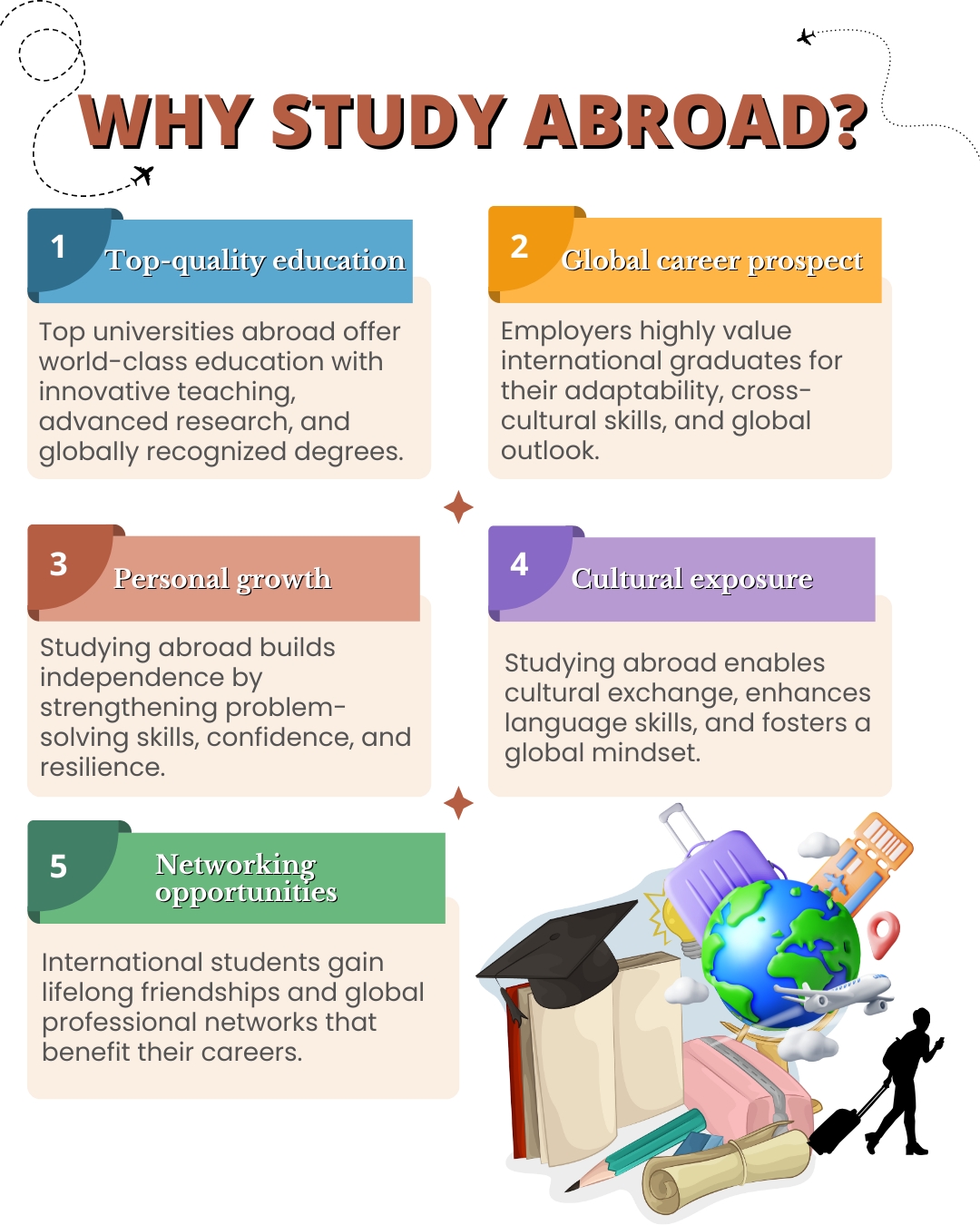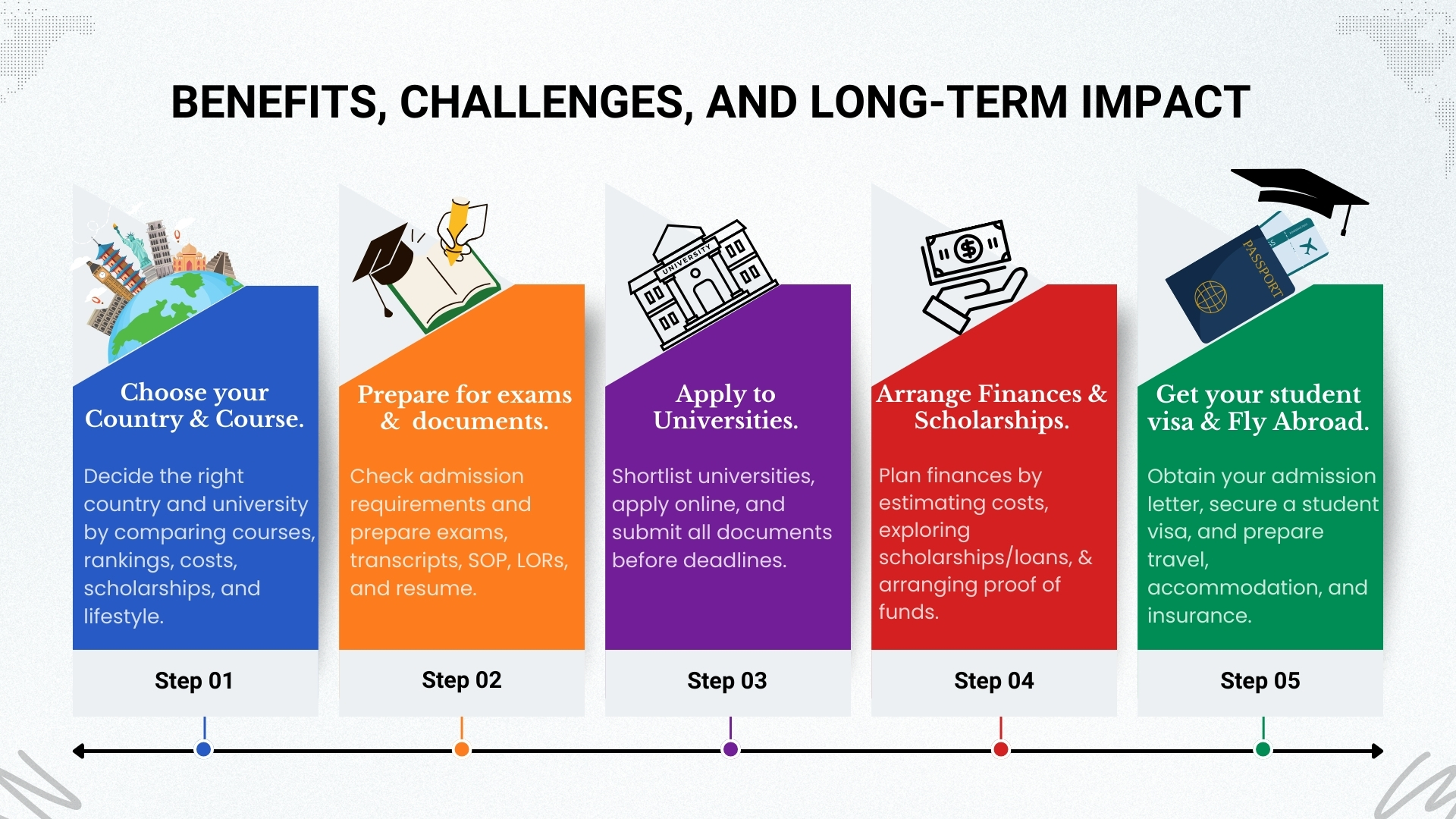
Telangana.India
Send an e-mail
Call Us Now
Studying ABROAD Benefits, Challenges, and Long-Term Impact
Studying abroad has become one of the most transformative experiences in higher education. Every year, millions of students leave their home countries to pursue academic opportunities overseas. This trend is fueled not only by the prestige of international universities but also by the desire for cultural exposure, global networking, and personal development. The experience provides students with the chance to gain a world-class education while simultaneously shaping their worldview and career prospects. However, alongside its many advantages, studying abroad also comes with significant challenges that require resilience, preparation, and adaptability.
This essay explores the benefits, academic excellence, and global perspectives associated with studying abroad, while also highlighting the financial, social, and emotional challenges students face. Ultimately, it argues that despite these obstacles, the overall advantages of international education far outweigh its drawbacks, making it a worthwhile pursuit for ambitious students worldwide

Before diving into the steps, let’s understand why studying abroad is worth considering.
Simply put, studying abroad is not just about what you learn in the classroom—it’s about the experiences, challenges, and opportunities that shape you into a more capable and confident individual.
Your journey starts with choosing the right country, university, and course that align with your academic and career goals. Every country has its own strengths. For example:
The US is known for research opportunities and flexibility in education.
The UK offers shorter degree durations and globally respected programs.
Canada is popular for affordable tuition, safety, and post-study work visas.
Australia is recognized for high-quality universities and a multicultural student community.
European countries like Germany and France often provide tuition-free or low-cost education in certain programs.
When making your choice, consider:
Course curriculum and faculty expertise.
Tuition fees and living costs.
Post-study work opportunities and immigration policies.
Climate, lifestyle, and cultural adaptability.
Scholarship availability.
Tip: Shortlist 3–4 countries and universities, then compare them carefully before finalizing.
Most international universities require certain standardized exams and supporting documents. Preparing these early will make your application process smoother.
Entrance exams:
Undergraduate students: SAT or ACT.
Graduate students: GRE or GMAT (especially for MBA and technical courses).
Language proficiency tests: IELTS, TOEFL, PTE, or Duolingo English Test are commonly required for non-native English speakers.
Key documents:
Academic transcripts – official records of your studies.
SOP (Statement of Purpose) – a personal essay that explains your goals, motivation, and why you chose a particular program.
LOR (Letters of Recommendation) – from professors, mentors, or employers who can vouch for your academic and personal qualities.
Resume/CV – highlighting your academic achievements, projects, internships, or extracurricular activities.
Tip: Start exam prep at least 6–12 months before your application deadline to ensure you score well.
Once you’ve chosen your target universities and prepared your documents, the next step is to apply.
Shortlist 4–6 universities in three categories:
Dream schools (highly competitive, top preference).
Match schools (your profile fits well with admission criteria).
Safe schools (higher chance of admission).
Apply through the university’s online portal or centralized platforms like UCAS (UK) or CommonApp (US).
Keep track of deadlines—some universities open applications a year in advance.
Upload documents in the correct format and proofread carefully to avoid mistakes.
Some programs may require interviews, essays, or entrance assessments.
Tip: Apply as early as possible to increase your chances of admission and scholarships.

Finances often feel like the biggest hurdle, but with the right planning, they can be managed effectively.
Estimate total costs: Include tuition, accommodation, food, transport, insurance, and travel.
Explore scholarships: Universities and governments often offer scholarships—merit-based, need-based, or program-specific.
Look for financial aid: Some countries provide grants or assistantships, while students can also apply for bank education loans.
Proof of funds: Visa applications usually require evidence of financial ability (bank statements, sponsor letters, or loan sanction letters).
Tip: Begin applying for scholarships at the same time as university applications. Many scholarships have strict early deadlines.
Once admitted, the final step is to get your visa and prepare for your big move.
Collect your admission letter (Offer/Acceptance).
Apply for a student visa with the required documents—passport, financial proof, acceptance letter, health records, and biometrics.
Book your flights and accommodation in advance.
Purchase health and travel insurance (often mandatory).
Attend pre-departure orientations offered by universities, embassies, or consultants to help you settle in smoothly.
Tip: Make a “departure folder” with physical and digital copies of important documents—passport, visa, academic certificates, medical records, and insurance.
High tuition and living costs make studying abroad expensive. Scholarships and part-time jobs help, but planning is vital.
Adapting to new traditions can cause culture shock. Everyday tasks and norms may feel unfamiliar at first.
Even fluent students may struggle with slang or accents. Miscommunication adds stress until practice improves skills.
Each country has unique visa and work regulations. Missing requirements can result in serious legal issues.
Healthcare abroad is costly & systems differ greatly. Stress & anxiety may rise without proper support.
Studying abroad may seem like a complex journey at first, but once you break it down into these five structured steps, it becomes clear and achievable. With thorough research, proper preparation, and early planning, you can move from being an aspiring student to becoming an international scholar.
The rewards—academic excellence, personal growth, cultural enrichment, and career advancement—make this journey worth every effort. So, if you’ve ever dreamed of studying overseas, now is the time to start planning your path and turning that dream into reality.
Munu International stands out as a prominent consultancy specializing in global education, committed to guiding Indian students in realizing their academic ambitions on the international front. Our resolute dedication to excellence and an enduring enthusiasm for education have established us as a reliable partner in helping students pursue their overseas study dreams.
Flat no:101, First Floor, Ameer Estate,
beside S.R. Nagar Bus stop, Ameerpet, Hyderabad-500038
Opp.Metro Pillar -1038
Copyright © 2023, All Rights Reserved By Munu International | Powered by Sky High Digitals